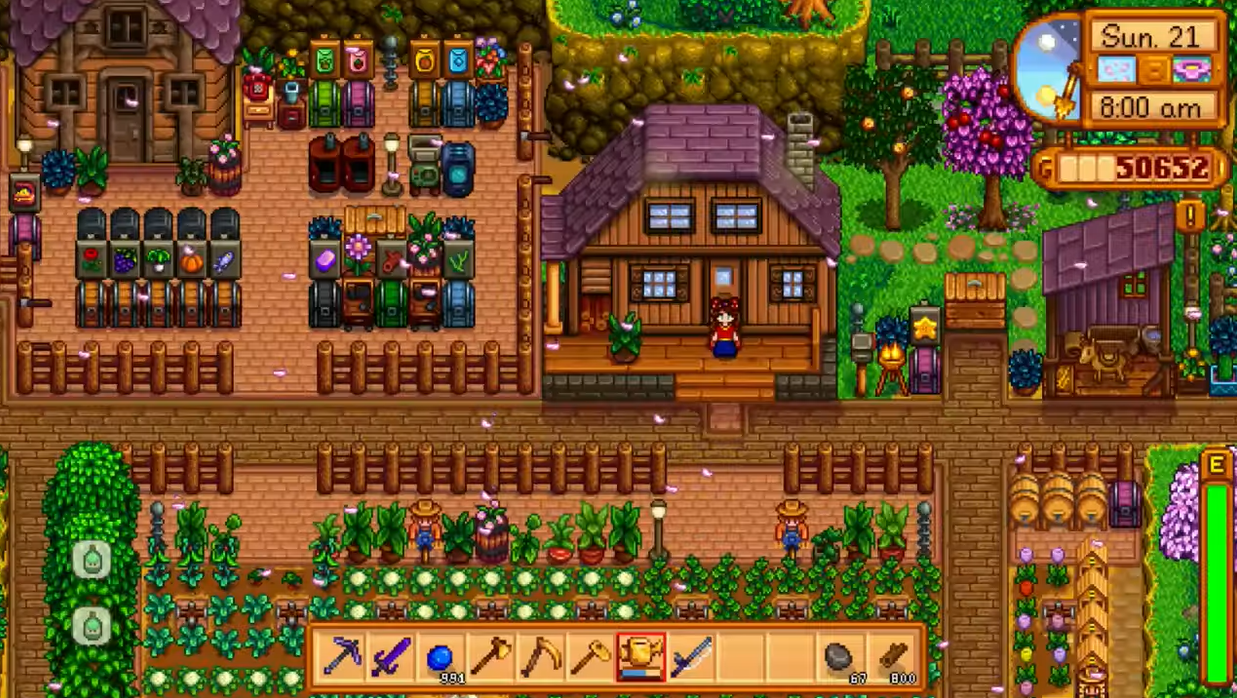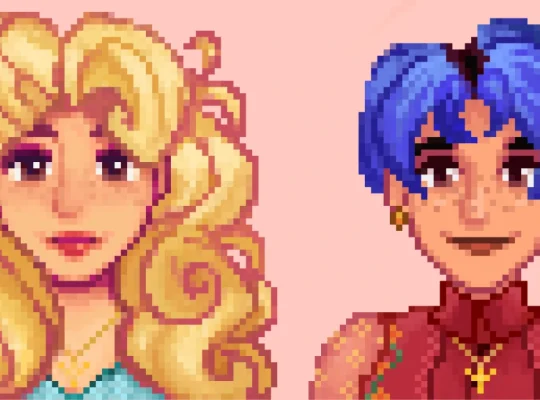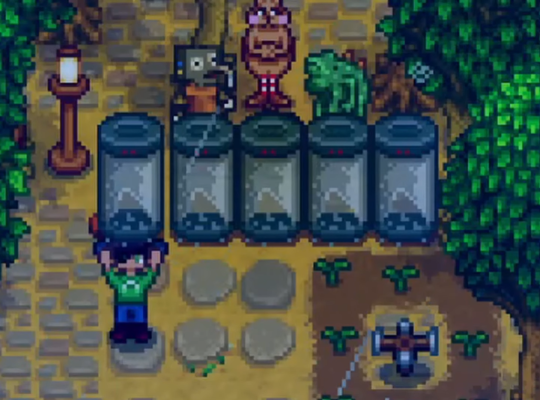Spring is a fresh start in Stardew Valley, and farming crops is a profitable way to generate income. With the arrival of Spring, the valley comes to life, and players can plant various crops that thrive during this season.
There are eleven exclusive Spring crops with varying values and growth times, and this guide aims to highlight the best crops to plant during Spring in Stardew Valley. Players can ensure a bountiful harvest and maximize their profits by focusing on these profitable crops!
10. Flowers (Blue Jazz and Tulips)

While not the most profitable options, Jazz and Tulip flowers add beauty to the farm and can be a delightful addition to the overall aesthetic.
These flowers can be sold for around 30-100 gold each, which may not be worth investing significant time and space. However, they can serve as excellent gifts to raise friendship levels with certain villagers who appreciate them.
Jazz flowers are known for their vibrant colors and delicate petals, while Tulips offer a classic and elegant appearance. Although they may not bring in substantial profits, their presence on the farm can enhance the overall atmosphere and create a more visually appealing environment.
Consider planting a few of these flowers to add charm and make the farm more inviting.
Pros
- It adds beauty to the farm and enhances the overall aesthetic.
- They can be used as gifts to raise friendship levels with certain villagers.
- Low initial investment cost.
Cons
- They are less profitable options in terms of selling price.
- Limited income potential compared to other crops.
- It takes up valuable space that could be used for more profitable crops.
9. Garlic
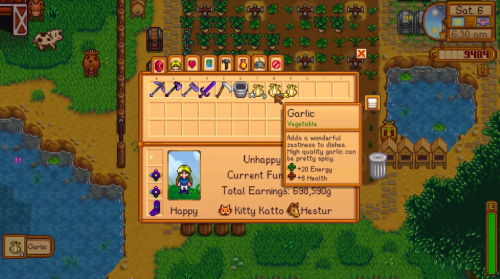
Garlic is an excellent choice for Spring crops in Stardew Valley. The seeds cost 40g at Pierre’s, and garlic can be sold starting at 60g or 120g at maximum quality.
This quick-growing crop is ready for harvesting in just four days, making it a profitable and efficient option.
In addition to its financial benefits, garlic is also essential for various recipes and can provide buffs when consumed before heading into the mines, such as Escargot, Fiddlehead Risotto, and Oil of Garlic. It’s a versatile crop that offers both immediate profit and long-term advantages.
Planting a section of the farm with garlic can be a wise decision, as it ensures a steady source of income and provides valuable resources for the player’s culinary and mining endeavors.
Pros
- Quick-growing crop, ready for harvesting in four days.
- Essential for cooking recipes and buffs in mining.
- It provides a minimum profit of 20g per garlic, with the potential for higher earnings at higher quality levels
Cons
- Relatively low selling price compared to some other crops.
- Requires regular replanting to maintain a consistent income.
- It may not be as versatile as other crops in crafting and bundling.
8. Parsnips
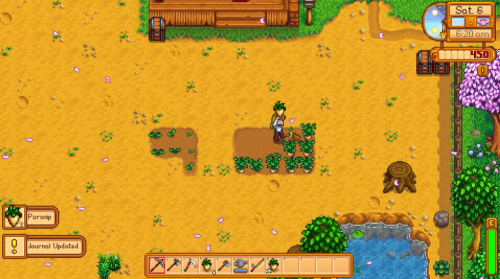
Parsnips are a staple crop in Stardew Valley and are an excellent choice for Spring planting. They take four days to grow and provide a guaranteed minimum net profit of 10 gold per parsnip.
Parsnips help cook recipes and fulfill bundles at the Community Center, making them a versatile and valuable crop. The crop is relatively easy to grow and requires minimal investment. They are perfect for players just starting or looking to make a steady income without taking too much risk.
Planting a substantial patch of parsnips in Spring can provide a reliable source of income and contribute to completing various objectives in the game.
Pros
- Staple crop in Stardew Valley takes four days to grow.
- It guaranteed a minimum net profit of 10 gold per parsnip.
- Essential for cooking recipes and fulfilling bundles at the Community Center.
Cons
- Relatively low selling price compared to some other crops.
- Limited profit potential if players invest heavily in large-scale parsnip farming.
- Less valuable for gift-giving to villagers compared to other crops.
7. Kale

Kale is another profitable Spring crop, with kale seed packets available for 70 gold. Kale can be sold for 110 to 220 gold, earning a net profit of 40g per crop. Investing in Kale is valuable, as it offers a higher return than other crops.
One of the advantages of kale is its resilience to weather conditions. Kale is a profitable crop and a valuable investment in the player’s farming business.
Pros
- It’s a profitable Spring crop with kale seed packets available for 70 gold.
- It can be sold for 110 to 220 gold, earning a net profit of at least 40 gold.
- It’s a valuable investment crop with a good return on investment.
Cons
- It requires a longer growth time of six days.
- Less versatile in terms of its use in cooking recipes or bundles.
- It may not be as visually appealing as other crops on the farm.
6. Green Beans
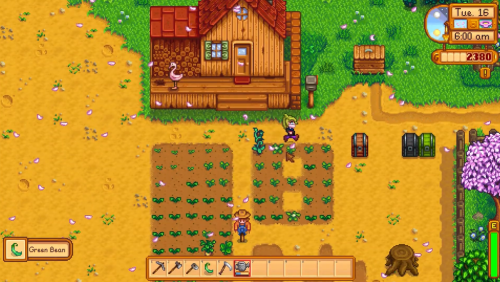
Green beans are an exciting choice for Spring planting due to their multi-harvest nature. While the initial cost of green bean seeds is 60 gold, they produce a crop that can be harvested multiple times. Green beans can be sold for 40 to 80 gold, providing a steady income throughout the season.
Once green beans have been planted and harvested for the first time. They will continue to regrow more beans every three days.
This continuous production makes them a reliable source of income and ensures that the player has a consistent flow of crops to sell. Green beans are great for players who prefer a more hands-on and interactive farming experience.
Pros
- Green bean seeds cost 60 gold but produce a multi-harvest crop.
- You can sell it for 40 to 80 gold per bean.
- Regrows more beans every three days after initial growth, providing a steady income stream.
Cons
- Relatively low selling price compared to some other crops.
- Requires regular harvesting to maximize profit potential.
- It takes up space in the field that could be used for other high-value crops.
5. Potatoes
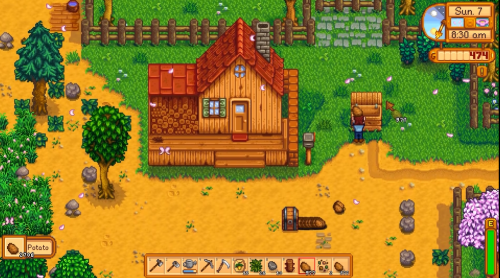
Potatoes are a classic root vegetable and a farm staple in Stardew Valley. With the seeds available for 50 gold, potato seeds offer a reliable source of income. Potatoes can be sold for 80 gold each or up to 160 gold at maximum quality, making them a profitable option for Spring planting.
With a growth period of six days, potatoes require slightly more patience than some other crops. However, their consistent returns and relatively low cost make them a worthwhile investment.
Potatoes can be a reliable source of income and provide a solid foundation for the player’s farming business in Spring.
Pros
- Root vegetable and farm staple, available for 50 gold.
- It can be sold for 80 gold or 160 gold at maximum quality.
- It’s a reliable source of income with a six-day growth period.
Cons
- Relatively low selling price compared to some other crops.
- Only profitable if players invest in large-scale potato farming.
- Less versatile in terms of its use in crafting or bundles.
4. Rhubarb
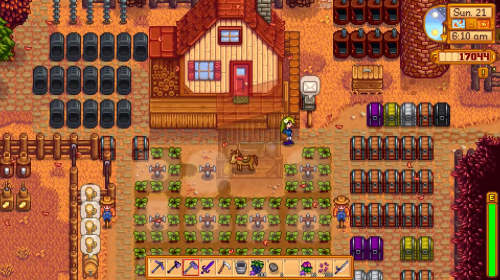
Rhubarb is an intriguing crop that offers high-profit potential in Stardew Valley. While the seeds cost 100 gold and can be obtained in the Oasis Shop at Calico Desert, the selling price for rhubarb ranges from 220 to 440 gold with high-quality crops. The investment in rhubarb is slightly higher, but the returns can be substantial.
It’s worth noting that rhubarb takes 13 days to mature, so players need to plan accordingly and be patient. However, the wait is usually worthwhile, as the selling price of rhubarb compensates for the more extended growth period.
Stardew Valley’s Rhubarb can be a lucrative choice for players willing to make a slightly more significant investment and exercise patience in their farming endeavors.
Pros
- Rhubarb seeds cost 100 gold and are available in the Calico Desert.
- The selling price ranges from 220 to 440 gold with high-quality crops.
- It offers a higher profit potential compared to some other crops.
Cons
- It offers a higher profit potential compared to some other crops.
- Higher initial investment cost compared to other crops.
- Limited availability and may require travel to the Calico Desert to purchase seeds.
3. Cauliflower

Cauliflower is a versatile and profitable crop that deserves consideration when planning Spring planting. With cauliflower seeds available for 80g, players can grow crops sold for 175g at standard or 350g at iridium quality.
The profitability of cauliflower can be further enhanced by choosing the Tiller profession, which increases crop profits by 10%. Cauliflower has a growth time of 12 days, which requires more planning and patience compared to other crops.
However, its high selling price and the potential for increased profits with the Tiller profession make it an attractive choice for Spring planting. Cauliflower can be a valuable addition to the player’s farming business with proper care and attention.
Pros
- Cauliflower seeds cost 80 gold and have a growth time of 12 days.
- It can be sold for 175 gold at standard quality and 350 gold at iridium quality.
- Tiller profession increases profits by 10%.
Cons
- It requires a longer growth time compared to some other crops.
- It has limited profit potential unless players invest heavily in large-scale cauliflower farming.
- Less versatile in terms of its use in cooking recipes or bundles.
2. Ancient Fruit
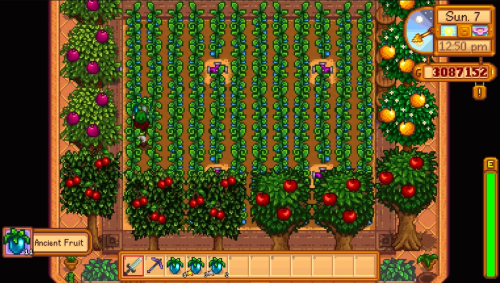
While not exclusive to Spring, Ancient Fruit can be grown during this season and in Summer and Fall.
Ancient Fruit is a rare and valuable fruit with a selling price ranging from 550 to 1,100 gold, depending on the quality. However, obtaining Ancient Seeds to grow Ancient Fruit can be more challenging.
Players can obtain Ancient Seeds through artifact donations at the museum or by purchasing them from the Traveling Cart. Once planted, Ancient Fruit provides a consistent source of income as they continue to produce fruit throughout the seasons.
While Ancient Fruit requires more effort to acquire, it can be an excellent long-term investment for players seeking substantial profits.
Pros
- Not exclusive to Spring but can be grown in Spring, Summer, and Fall.
- Sells for at least 550g minimum, and 1,100g at maximum quality.
- It provides a consistent income source with high profit throughout multiple seasons.
Cons
- Requires obtaining Ancient Seeds through artifact donations or the Traveling Cart.
- Initial seed acquisition can be challenging and time-consuming.
- It has a longer growth time than most Spring crops.
1. Strawberries
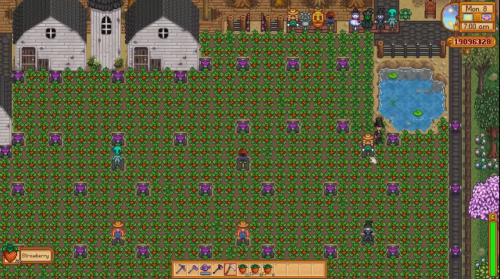
Considered the best Spring crop in Stardew Valley [1], strawberries should be noticed by players looking to maximize their profits.
Available at the Egg Festival for 100g, strawberries can be sold for 120g to 240g, depending on the quality. One of the critical advantages of strawberries is their regrowth rate, as they produce more fruit every four days.
This regrowth feature makes strawberries a reliable and consistent money-maker throughout Spring. By planting a significant patch of strawberries, players can ensure a steady income and earn a substantial profit.
Strawberry crops are highly recommended for players who want to make the most out of their Spring harvest.
Pros
- It’s the best Spring crop available at the Spring Egg Festival for 100 gold.
- It can be sold for 120 to 240 gold depending on quality.
- It regrows every four days, making it a reliable money-maker in the game.
Cons
- It has limited availability during the Spring Egg Festival.
- This crop requires careful planning and preparation to maximize profit potential.
- It may require a significant initial investment in seeds and infrastructure.
Farming Tips for Maximizing Crop Yield and Profit
Proper watering: Ensure your crops are watered daily for optimal growth and yield. Use sprinklers or upgraded watering cans to save time and energy in watering your crops.
Fertilizer usage: To enhance crop quality and yield, you must apply quality fertilizer. Quality fertilizer can be crafted using 1x Sap and 1x Any fish.
Crop rotation: You should avoid planting the same crop in the same area season after season. Crop rotation helps prevent soil exhaustion and improves overall crop health.
Greenhouse utilization: You can unlock the greenhouse as soon as possible to extend the growing season for high-value crops. Utilize the greenhouse to grow not season-dependent crops, such as ancient fruit.
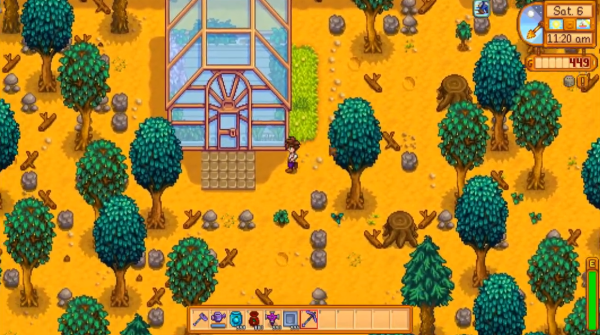
Efficient layout: You should plan the structure of your farm to maximize space and efficiency. Minimize walking distances between crops and utilize scarecrows and sprinklers effectively.
Community Center bundles: You can complete bundles at the Community Center to unlock rewards and bonuses, including crops. Prioritize crops needed for bundles to make progress and unlock valuable items.
Utilize farming professions: Choose farming professions that align with your crop choices. Professions like Agriculturist (faster crop growth) and Artisan (increased artisan good profits) can significantly enhance your farming income.
Final Thoughts
While flowers like Jazz and Tulips add beauty to the farm, they may not be the most profitable options. However, they can serve as gifts to raise friendship levels. Garlic and parsnips are reliable choices that provide consistent profits and fulfill various requirements in recipes and bundles.
By following this guide and making informed decisions about which crops to plant in Spring, players can enjoy a fruitful season filled with financial success and a sense of accomplishment.

